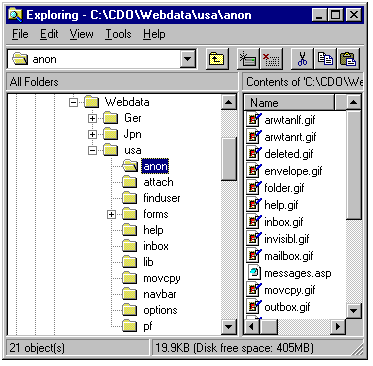
| Platform SDK: CDO 1.2.1 |
After the Microsoft® Exchange Active Server™ components are installed on a server, the files of Microsoft® Outlook™ Web Access reside in a directory structure similar to that in the following illustration. A directory tree exists for each language you install; in the illustration, the usa tree is expanded, and some of the files in the usa\anon subdirectory are listed in the right pane.

The ASP files used by Microsoft Exchange Active Server components reside in these subdirectories. For example, the \inbox directory contains .asp files used by the Active Server components to display a user's mailbox and its contents. Other subdirectories contain files for other uses; for example the \anon directory contains files that are rendered to show public folders and their contents to an unauthenticated user, whereas the files in \pf are used when an authenticated user accesses public folders.
The \forms directory and its subdirectories contain scripts for every form. The structure of the \forms directory is based on the message class of the form; the .asp files in each directory are named after the verb that is applied — such as read.asp and compose.asp. For example, an IPM.Note is read using the file read.asp in the directory \forms\ipm\note. Customizers can install additional forms for each message class they define using the same structure. This structure is loaded at application start.